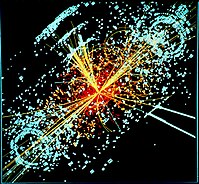
Photo from wikipedia
The current paradigm for dark matter direct detection is to assume that the dark sector is solely composed of a single particle species. In this short paper, we make the… Click to show full abstract
The current paradigm for dark matter direct detection is to assume that the dark sector is solely composed of a single particle species. In this short paper, we make the observation that dark matter comprising both a light and a heavy component that modulate out of phase leads to interesting phenomenology in annual modulation experiments. For an illustrative example, we use the recently released DAMA/LIBRA phase-2 results with a lower energy threshold. Immediately after, it was argued that a one-component spin-independent dark matter explanation of the observed annual modulation is strongly disfavored or excluded unless isospin-violating couplings are invoked. We show that a simple two-component extension can reproduce the observed spectrum without the need to invoke fine-tuned couplings. Using the publicly available DAMA/LIBRA data, we perform a fit of the DAMA/LIBRA energy spectrum of the annual modulation amplitude to a scenario with two dark matter components. We also take into account how gravitational focusing affects the phases of the light and a heavy components differently, which leads to nontrivial effects in the total time-dependent rate. Our results show that there exists a unique solution in agreement with the data in the simplest case of isospin-conserving couplings with equal cross sections. The distinctive features found in this work are crucial for a dark matter interpretation of any observed annual modulation.
Journal Title: Physical Review D
Year Published: 2018
Link to full text (if available)
Share on Social Media: Sign Up to like & get
recommendations!